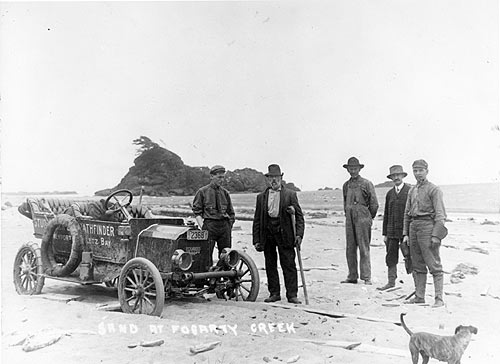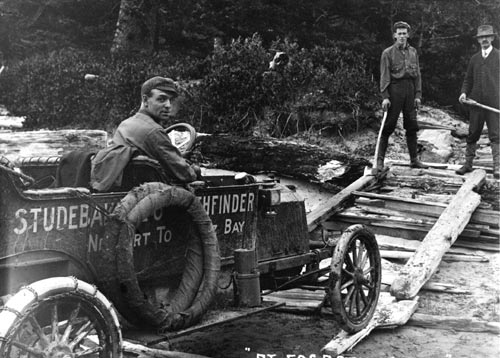Historical Surprise: Pristine Oregon Coast Result of When Beaches Were Roads
Updated Periodically
By Oregon Coast Beach Connection staff

(Oregon Coast) – Driving along Highway 101, gazing over pristine, sandy beaches that flash by, often between stands of forests or bubbly hillsides, you're probably not aware of the inherent irony in this. As you zip along the Oregon coast scenic highway, you're looking at the old coastal highway. (Photo above: A mail carrier from Waldport has a close call in 1913 in the Newport area - courtesy Lincoln County History Museum, Newport)
It always comes as some surprise to find out Oregon's beaches were at one point the main road up and down this shoreline. There was no actual road for many decades after European settlers starting arriving here.
Even more surprising, the fact they were once the only highway between towns is directly related to the enduring beauty of this area – it is part of the reason they are so public. And ultimately so clean as well.
 Highway 101 didn't actually come into existence until the early '30s. Before that, all you could do to get to most places was drive up the beach by horse 'n' buggy or by early models of motorcar.
Highway 101 didn't actually come into existence until the early '30s. Before that, all you could do to get to most places was drive up the beach by horse 'n' buggy or by early models of motorcar.
About the only real sign left of this is the old road carved out of Hug Point near Cannon Beach. Just after 1900, the rock here was blasted apart and a small road made around this point. You can still see the ruts in the old rock, etched by the wheels of ancient vehicles. (Photo here, courtesy Cannon Beach History Museum)
In 1914, Governor Oswald West declared the beaches public highways, as part of a first step to keep the roads open and assure more would be built. Shortly after, a series of unpaved roads began to spring up. The Columbia Highway was to run from Seaside to Astoria and then along the Columbia River to Pendleton. In 1915, an unpaved highway between Astoria and Portland opened up.
Meanwhile, down in Newport, Nye Beach and Newport were actually separate little villages, connected by a muddy set of wooden planks.
In 1912, a group of central coast businessmen hoped to give local tourism a big boost by making the first automobile trip between Newport and Siletz Bay in what would later become Lincoln City. These days, along 101, the trip takes 45 minutes to a half hour, depending on traffic. Back then, the group that called itself the Pathfinders needed 23 hours to make the round trip along muddy tracks on slippery hillsides and soft beaches.
Mail was, of course, delivered by sauntering over the vehicle-stressing beaches as well. This resulted in a flurry of interesting tales all their own. One that stands out was the discovery of a mail truck from the '20s beneath the sands of Waldport, found in early 2008 when sand levels reached record lows.
It wasn't until 1919 that Oregonians approved a measure to create a full highway from border to border along the coastline, partially because of the way World War 1 had caused Americans to start thinking about emergency preparedness and other possible wars. In 1921, actual paving work began on what was then called the Roosevelt Coast Military Highway – after Theodore Roosevelt.
It changed names again over the next few years, including the Oregon Beach Highway, before finally settling on the Oregon Coast Highway in the early '30s. Part of that initial name still sticks today: Highway 101 in Seaside is known as Roosevelt Street.
Highway 101 was paved and finished in the early '30s (parts of it later). Then, and only then, could coastal towns connect with each other. According to some state documents, Oregonians at the time discovered incredibly different cultures had evolved in each coastal town, the result of decades of isolation from each other and the rest of the state.
After West's declaration that beaches were to be public, several laws were passed giving the Highway Commission more control over the beaches over the years. The Oregon State Parks system was an offshoot of this legislation, starting under the highway department in 1925.
All this helped pave the way for Gov. Tom McCall to finalize Oregon's beaches as public in the '60s, but before that it was simply a kind of unclarified law and understanding. What really inspired the famed Oregon Beach Bill was when a Cannon Beach motel owner tried fencing off a portion of the dry sand in front of his beachfront property in 1966.
This did not sit well with locals and they went straight to Oregon legislators. The Oregon Beach Bill, based slightly on a similar bill in Texas, nearly died a quick death. But McCall created overwhelming public support by flying a team of scientists to the beach in a helicopter, thus creating a massive media stir that turned it into a hot button issue for Oregonians.
The was signed into existence on July 6, 1967. Oregon Coast Lodgings for this - Where to eat - Maps and Virtual Tours Historic photos below:



Photos above courtesy Lincoln County History Museum, Newport

More About Oregon Coast hotels, lodging.....
More About Oregon Coast Restaurants, Dining.....
Cannon Beach Lodging
Nehalem Bay Lodgings
Manzanita Hotels, Lodging
Three Capes Lodging
Pacific City Hotels, Lodging
Lincoln City Lodging
Depoe Bay Lodging
Newport Lodging
Waldport Lodging
Yachats Lodging
Oregon Coast Vacation Rentals
Oregon Coast Lodging Specials
LATEST Related Oregon Coast Articles
Likely just before dawn best hour but peak happens during daylight. Weather
Dark Sky Week is Prime Along Oregon Coast: Where and Where Not to Go
General guide to dark sky viewing from south to north coast. Astronomy
Sizable Price Drop, Deals in Lincoln City During Quiet of April on Central Or...
20 perc off at A1 Vacation Rentals across its roster, including Gleneden Beach. Lincoln City specials
Upcoming S. Oregon Coast Events Include Gem Show, History: Coos Bay, Bandon
May 6 talk at Coos History Museum, Mayfly Fest May 17, Bandon Rock / Gem Show June 7,8
Washington Coast Cleanup on April 19 - Coinciding with Oregon Coast's SOLVE E...
From the Puget Sound to Long Beach, alongside Oregon's cleanup. Washington coast events, Seaside events
Astoria's Riverwalk Gets New Lighting, More N. Oregon Coast Roadwork
Delays coming this summer, but the riverwalk has a new look. Seaside, Cannn Beach
April Gets Even Cheaper Midweek at Depoe Bay, Lincoln City: Oregon Coast Deals
Off-season rates plus more at Keystone Vacation Rentals. Depoe Bay lodging specials, Lincoln City hotel reviews, Newport hotel reviews
Washington Coast Begins Week of Clam Digs, April 12 Through 18
Long Beach, Twin Harbors, Mocrocks and Copalis at different times. Washington coast events
Back to Oregon Coast
Contact Advertise on BeachConnection.net
All Content, unless otherwise attributed, copyright BeachConnection.net Unauthorized use or publication is not permitted


















































